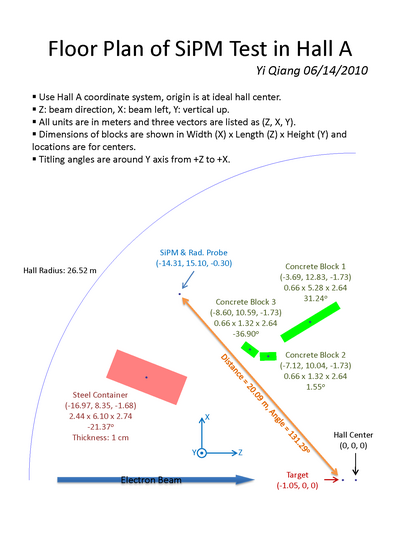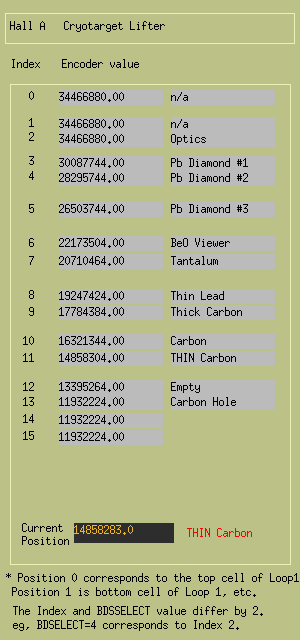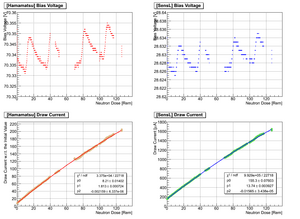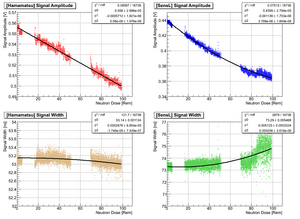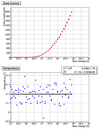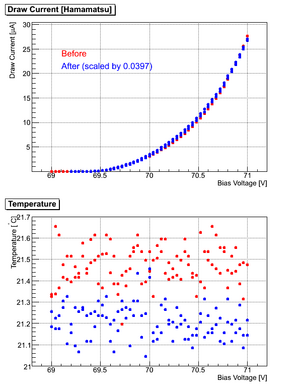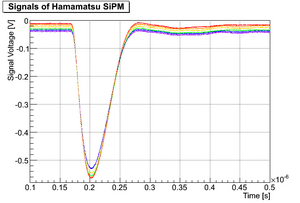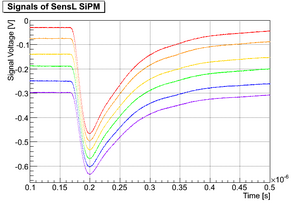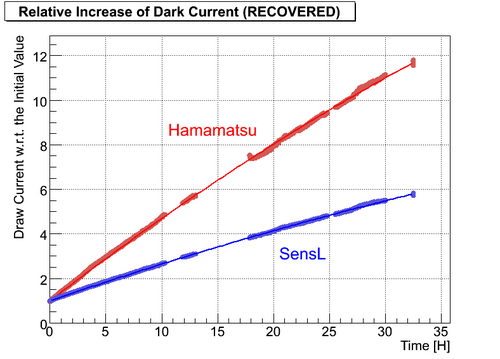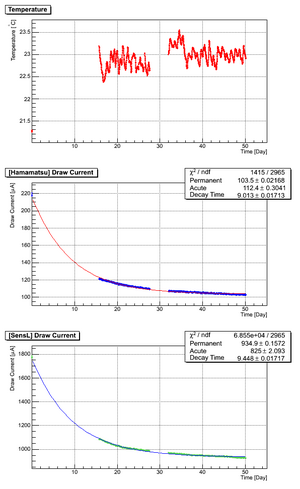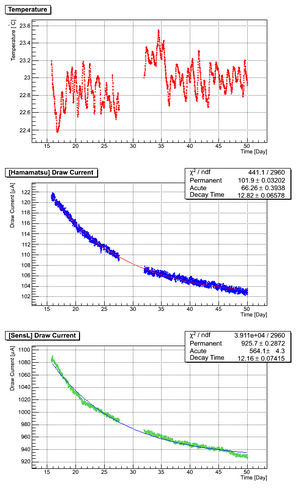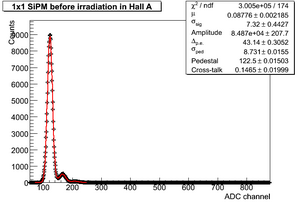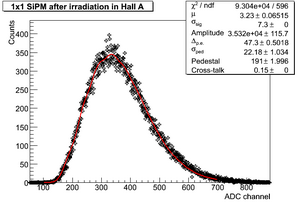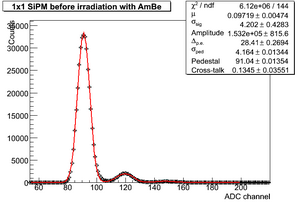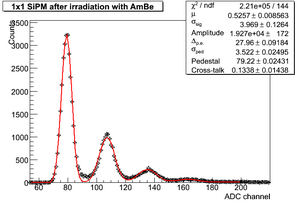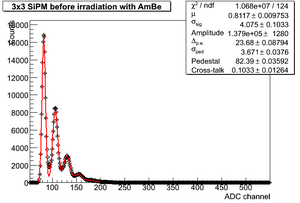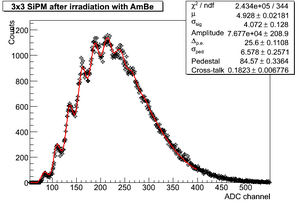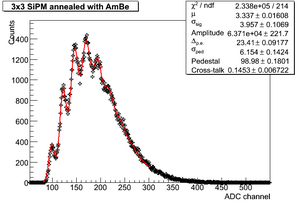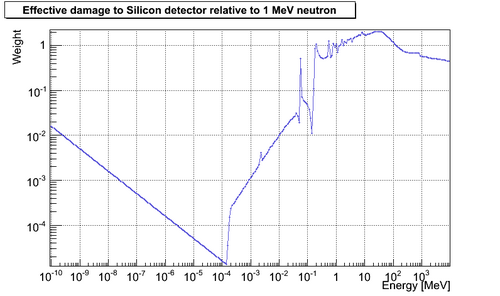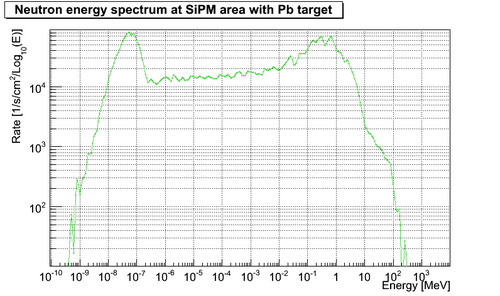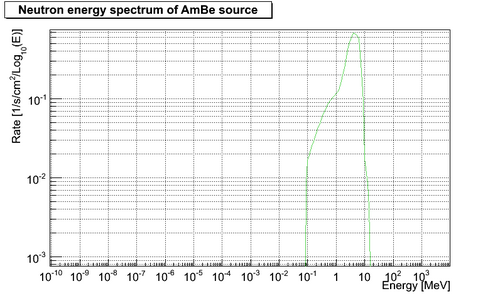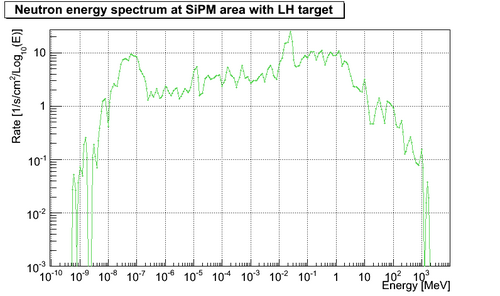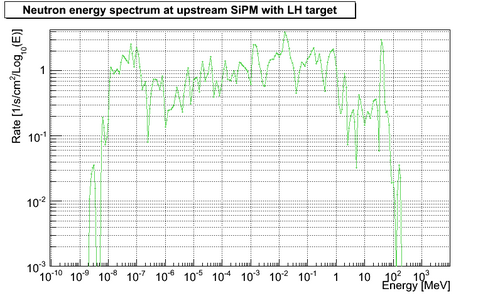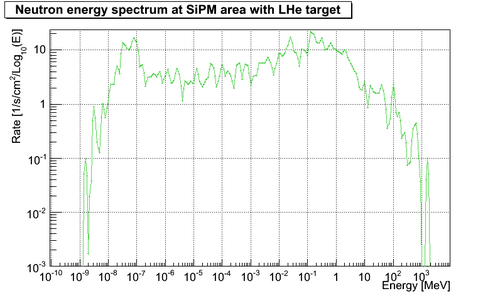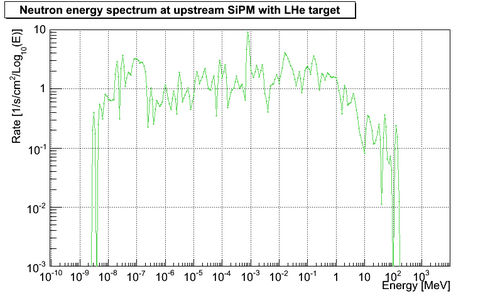Difference between revisions of "SiPM Radiation Hardness Test"
From GlueXWiki
(→Test Result) |
(→Compared to Hall A Result) |
||
| Line 367: | Line 367: | ||
** 1 MeV equivalent neutron fluence: '''8-6 n<sub>eq</sub>/s/cm<sup>2</sup>''' | ** 1 MeV equivalent neutron fluence: '''8-6 n<sub>eq</sub>/s/cm<sup>2</sup>''' | ||
| − | === Compared to Hall A Result === | + | === Compared to Hall A Simulation Result === |
* To reach 10 times (50% recovery included) higher dark current of SiPM in Hall A: 27 hours of 50 μA beam → 84 rem → '''2×10<sup>9</sup>n<sub>eq</sub>''' | * To reach 10 times (50% recovery included) higher dark current of SiPM in Hall A: 27 hours of 50 μA beam → 84 rem → '''2×10<sup>9</sup>n<sub>eq</sub>''' | ||
Revision as of 16:26, 23 August 2010
SiPM Radiation Hardness Test in Hall A
Contents
Test Plan
The Draft Test Plan to Study Radiation Damage to SiPMs in Hall A
System Diagram and Floor Plan
Device List
- Control Computer: transversity.jlab.org: (129.57.164.28)
- GPIB over IP: GPIB-ENET/100: agpib.jlab.org (129.57.192.73)
- Serial Port Server: ESP904: portservha50.jlab.org (129.57.192.78)
- USB over IP: AnywhereUSB/5: ausb.jlab.org (129.57.192.75)
- Oscilliscope: TDS3034: dosci.jlab.org (129.57.192.77)
- Power Outlet: APC Outlet Control: hlauser:hlauser@hareboot12.jlab.org (129.57.192.76)
- Outlet 1: Pulse Generator
- Outlet 2: Temperature Box
- Outlet 3: Oscilliscope
- Outlet 4: GPIB over IP
- Outlet 5: Power Supply for Hamamatsu Unit
- Outlet 6: Power Supply for SensL Unit
- Outlet 7: Picoamp Meter
- Outlet 8: Serial Port Server
- USB to Serial HUB: ComHUB
- Serial 1 (COM5): Power Supply for Hamamatsu Unit
- Serial 2 (COM6): Power Supply for SensL Unit
- Serial 3 (COM7): Oscilliscope
- Serial 4 (COM8): Temperature Box
- Picoamp Meter x2: Keithley-485 (GPIB)
- GPIB Address: 1 (Hamamatsu); 2 (SensL)
- Pulse Generator: HP-8116A (GPIB)
- GPIB Address: 4
- Power Supply x2: B&K-1787B (RS232)
- Temperature Meter: CN77544 (RS232)
Power Connection and Settings
- Power Cable Color Code
- Black: Ground
- Yellow: -5.0 V
- Red: +2.1 V
- Blue: Hamamatsu Bias Voltage
- Green: SensL Bias Voltage
- SiPM Bias Voltage Correction vs Temperature
- Hamamatsu: 56 mV/C (70.27 at 20 C)
- SensL: 23 mV/C (28.6 at 20 C)
EPICS Variables
Hall A Beam Line IOC: iocha5.jlab.org [129.57.188.5]
- hac_bcm_average: Hall A beam current (uA)
Hall A Cryo Target IOC: iocha13.jlab.org [129.57.188.29]
- haBDSPOS.VAL: Hall A cryo target position (encoder value)
MCC general IOC: 129.57.255.4
- rad44_p2: Neutron dose [mRem/hour]
- rad44_p2_dose: Accumulated Neutron dose [mRem]
- rad44_p1: Gamma dose [mRem/hour]
- rad44_p1_dose: Accumulated Gamma dose [mRem]
SiPM Test Log
3x3 mm2 SiPM Test in Hall A
Test Condition
- Time: 04/20/2010 12:30 PM
- Location: Hall A beam left
- Initial Dose
- Neutron (rad44_p2) 18.4 mRem
- Gamma (rad44_p1) 61900 mRem
- Radiation Chips
- Neutron Rod: serial# 2A01 close to SiPM
- TLD: serial# 9597, close to SiPM and rad44_p2
- TLD: serial# 9598, close to rad44_p1 at entrance
Pre-Rad Measurement
- Voltage vs Current scan done
- Hamamatsu: 20100420_132141_VICurve.txt
- Hamamatsu: 20100420_132531_VICurve.txt
- SensL: 20100420_132531_VICurve.txt
- SensL: 20100420_132531_VICurve.txt
Beam ON Test
- Oscilloscope Snapshot #1: 20100420_135400_CHx.txt
- Oscilloscope Snapshot #2: 20100421_014000_CHx.txt
- Oscilloscope Snapshot #3: 20100421_091100_CHx.isf
- Oscilloscope Snapshot #4: 20100421_182200_CHx.isf
- Oscilloscope Snapshot #5: 20100422_015300_CHx.isf
- Oscilloscope Snapshot #6: 20100422_102700_CHx.isf
- Dataset #1: 20100420_140630.txt
- Stopped due to GIPB problem
- No production
- Dataset #2: 20100420_182713.txt
- Long run with production started
- 22:40:30 - 01:46:10 oscilloscope not updating
- Stopped due to GPIB problem
- Dataset #3: 20100421_091253.txt
- Stopped due to EPICS problem
- Dataset #4: 20100421_105132.txt
- HV OFF at 10:59:00 to test radiation damage with bias voltage OFF
- Stopped to turn bias voltage back ON at 18:21:00
- Dataset #5: 20100421_182344.txt
- New dataset with bias voltage ON
- Stopped due to GPIB problem
- Dataset #6: 20100422_015736.txt
- Stopped due to GPIB problem
- Dataset #7: 20100422_091215.txt
- Beam OFF
- oscilloscope not updating
Post-Rad Measurement
- Voltage vs Current scan done
- Hamamatsu: 20100422_105000_VICurve.txt
- Hamamatsu: 20100422_105334_VICurve.txt
- SensL: 20100422_105732_VICurve.txt
- SensL: 20100422_110249_VICurve.txt
Plots
- Change of draw Current and signal shape at working condition as a function of radiation
- Comparison of VI response before and after radiation
- Signals recorded by oscilloscope show the effect of radiation on amplification: red (initial) -> violet (final)
- If we take the dose to fluence coefficient of 1 MeV Neutron: 400 pSv.cm2 = 4x10-8 rem.cm2 (1 mrem/H -> 6.9 neq/s/cm2), we have the following plot
Aneeling of Radiation Damage
Facts and Conclusions
- Hall A radiation level is extremely high during P-REX experiment: 50uA on 0.5mm Pb target (9% radiation length).
- A lot of energy dumped to the 2 pieces of collimator behind Pb Target: estimated 1 kiloWatt total power dissipated on them.
- The neutron dose rate before the collimator installed was 1.55 rem/H with 45 uA beam on Pb target. After the collimator was installed, the dose rate during the SiPM test was 1.35 rem/H with 50 uA beam. Therefore the tungsten collimator did not significantly change the radiation level.
- Radiation causes draw current to increase no matter whether bias voltage is applied.
- Hamamatsu: starting from 8 uA, 5 uA/Rem
- SensL: starting from 155 uA, 40 uA/Rem
- The dark current from both SiPM samples recovered by about 50% with time constant of 10 days
- Taking the bias voltage adjustment into account, the dark current has an exponential relation to the ambient temperature:
- I(dark) ~ exp(a*(T-T0))
- a for Hamamatsu: 0.061±0.003/C
- a for SensL: 0.047±0.002/C
- Radiation slowly affects the amplification of SiPM but has no effect on the signal width, even though, the drops of the gain get fully recovered afterward.
- Report to GlueX meeting (2010/05/10): link to docDB
- Dark rate measurement shows a increase of noise level consistent with the increase of dark current:Carl's report
- I(dark) ~ Sigma(pedestal)^2
1x1 mm2 SiPM Test in Hall A
Test Condition
- Same location as previous 3x3 SiPM test: 135 degrees, 20 meters
- Not powered
- Temperature: ~ 21.3 degree C
- SiPM information:
- Type Number: S10362-11-050C
- Serial Number: 1260
- Vop: 71.54 V
- M: 7.50e+5
- Dark Rate (0.5 p.e.): 536 kcps
- Dark Rate (1.5 p.e.): 44 kcps
- X-talk: 8.2%
- PDE (lambda = 490 nm): 36.5%
- At 25 degree C
Initial Neutron Dose 2010/06/11 11:20 AM
- rad44_p2_dose: 0 Rem
Final Neutron Dose 2010/06/15 10:00 AM
Test Result
- ADC dark spectrum before irradiation
- ADC dark spectrum post irradiation
- ADC dark spectrum 2 months later
- Note
- The pre-amplifier used in the first two tests (before and post) was from Stepan with a total gain of 105 while during the last test (anneal) the pre-amplifier from Fernando was used with a gain of 65.
- Permanent damage increases dark rate by 21
- Permanent damage increases dark current by 18: Carl's measurement
- Cross-talk: 15%
Test with RadCon AmBe Source
Test Condition
- The AmBe source has an narrow neutron energy spectrum averaged at 4 MeV [1] page82
- The AmBe source in RadCon has the following dose rate:
dose rate = [13/D2]*[1+(0.248*D)2.2375*e-0.3536*D] mrem/H
where D is the distance from the source in the unit of meter
- One 1×1 mm2 and one 3×3 mm2 SiPMs together with their pre-amplifiers were irradiated by this source
- The distance is 17 cm and dose rate is 0.45 rem/H
- Test started at 14:40 July 12, 2010
- Test stopped at 14:25 July 15, 2010
- Total dose: 32±2 rem
Results
- Increase of dark current:
- 1×1 mm2: 6.4
- 3×3 mm2: 7.1
- average: 6.8
- expected increase of dark current after annealing (time constant: 10 days, radiation: 72 hours, measurement: 96 hours): 4.2
ADC Dark Spectrum
1x1 mm SiPM
- Before irradiation
- After irradiation
- 1 month later
- Note
- Permanent damage increases dark rate by 3.5
- Permanent damage increases current rate by 4: Carl's Measurement
- Cross talk: 13%
3x3 mm SiPM
- Before irradiation
- After irradiation
- 1 month later
- Note
- Permanent damage increases dark rate by 4.1
- Permanent damage increases current rate by 4.7: Carl's Measurement
- Cross talk: 14%
Damage Conversion and Fluence Simulation of Hall A
Interpret neutron flux into rem and fluence
- Equivalent neutron radiation damage to silicon detector normalized to 1 MeV neutron [2], as recommended for LHC silicon detector study.
- Neutron dose equivalent conversion coefficients were taken from ICRP 74, plot see [3], may off by a factor of 2.
Updated Hall A simulation
- Neutron Energy spectrum [4]
- Dose rate to fluence: 1 mrem/H → 6.7 neq/s/cm2
- Dose rate: 3.1 rem/H (1.3 rem/H measured)
- Ideal dose rate with 0.5 mm Pb target and 50 μA is 7.6 rem/H
- Actual target thickness was reduced to 40% due to the beam damage
- 03/28/2010 11:00: 950 mrem/H@22.8 μA → 2.12 rem/H@50 μA (Pb#3 first time in beam)
- 04/06/2010 07:00: 1.53 rem/H@44.2 μA → 1.73 rem/H@50 μA (Pb#3 last time w/o collimator)
- 04/16/2010 02:00: 0.99 rem/H@18.0 μA → 2.75 rem/H@50 μA (Pb#3 first time w/ collimator)
- 04/20/2010 22:00: 1.41 rem/H@49.7 μA → 1.42 rem/H@50 μA (Start of SiPM test)
- 04/22/2010 09:00: 1.30 rem/H@49.5 μA → 1.31 rem/H@50 μA (End of SiPM test)
- 1 MeV equivalent neutron fluence: 21000 neq/s/cm2
AmBe neutron source
- Neutron Energy spectrum
- Dose rate to fluence: 1 mrem/H → 9.3 neq/s/cm2
- Dose to permanently increase dark current by factor of 10: 76 rem
- 1 MeV equivalent neutron fluence: 2.5×109 neq/cm2
Agreement of Hall A simulation and measurement
- In Hall A, with Pb target, it took 35 rem(27 hours) to permanently increase the Hamamatsu 3×3 SiPM dark current by a factor of 10.
- 35 rem → 8.4×108 neq/cm2.
- Recorded dose rate is 1.3 rem/H.
- If we assume that the neutron probe underestimate the neutron dose in Hall A because it's not sensitive to high energy neutron (E>20 MeV)
- The correction factor should be: 2.5×109/8.4×108 = 3.0
- The actual dose rate is 1.3×3.0 = 3.9 rem/H !
- Quite consistent with Pavel's calculate (3.1 rem/H) now!
Fluence simulation of Hall D
Pavel recently updated his simulation for the neutron flux through SiPMs with normal Hall D production condition.
Simulation Condition and Results
- Detector location: Z = 462 cm
- Rate of photon beam before collimator: 11 GHz
- Dose rates and energy spectra with Hydrogen target
- Flux in downstream SiPM area with Hydrogen target
- Flux in upstream SiPM area with Hydrogen target
- Dose rates and energy spectra with Helium target
- Flux in SiPM area with Helium target
- Flux in upstream SiPM area with Helium target
Hydrogen Target
Downstream Detector
- The energy spectrum of neutron from Hydrogen target:
- Dose rate to fluence: 1 mrem/H → 7.1 neq/s/cm2
- At 65-90 cm
- Dose rate: 4.3-3.3 mrem/H
- Total neutron flux: 90-76 Hz/cm2 (54-43 forward, 37-33 backward)
- Neutron flux > 10 MeV: 4.3-2.6 Hz/cm2 (3.1-1.7 forward, 1.2-1.0 backward)
- 1 MeV equivalent neutron fluence: 31-23 neq/s/cm2
Upstream Detector
- The energy spectrum of neutron from Hydrogen target:
- Dose rate to fluence: 1 mrem/H → 7.6 neq/s/cm2
- At 65-90 cm
- Dose rate: 1.0-0.4 mrem/H
- Total neutron flux: 20-16 Hz/cm2 (3.5-3.2 forward, 17-13 backward)
- Neutron flux > 10 MeV: 0.7-0.4 Hz/cm2 (0.1-0.0 forward, 0.6-0.4 backward)
- 1 MeV equivalent neutron fluence: 8-3 neq/s/cm2
Helium Target
Downstream
- The energy spectrum of neutron from Helium target:
- Dose rate to fluence: 1 mrem/H → 7.2 neq/s/cm2
- At 65-90 cm
- Dose rate: 6.5-4.9 mrem/H
- Total neutron flux: 140-108 Hz/cm2 (94-67 forward, 46-41 backward)
- Neutron flux > 10 MeV: 7.0-4.0 Hz/cm2 (5.6-3.0 forward, 1.3-1.1 backward)
- 1 MeV equivalent neutron fluence: 47-35 neq/s/cm2
Upstream
- The energy spectrum of neutron from Helium target:
- Dose rate to fluence: 1 mrem/H → 6.6 neq/s/cm2
- At 65-90 cm
- Dose rate: 1.2-0.8 mrem/H
- Total neutron flux: 35-28 Hz/cm2 (4.0-3.8 forward, 31-24 backward)
- Neutron flux > 10 MeV: 1.5-1.1 Hz/cm2 (0.5-0.1 forward, 1.0-1.0 backward)
- 1 MeV equivalent neutron fluence: 8-6 neq/s/cm2
Compared to Hall A Simulation Result
- To reach 10 times (50% recovery included) higher dark current of SiPM in Hall A: 27 hours of 50 μA beam → 84 rem → 2×109neq
- At 65-90 cm (inner-outer radius of BCal), to reach same radiation level:
- Hydrogen target: 2.0-2.8 years for downstream and 8-21 years for upstream of full-time running
- Helium target: 1.3-1.8 years for downstream and 8-11 years for upstream of full-time running
Future Test Plan with Radcon AmBe Source
Tests with previously irradiated samples
- Revisit noisy 1x1 mm2 SiPM sample from Hall A
- Uniformity test of the 4x4 3x3 mm2 array from Hall A
- Measure permanent damage of all the irradiated samples
Temperature test with AmBe source
- Purchase 12 1x1 samples from Hamamatsu product page
- Set up a DAQ test platform in F117
- Irradiate all of them with AmBe source to 30 rem (4 days), 6 at 0 degree, 6 at room temperature
- Annealing test of all the samples at three different temperatures: 0, 20 and 60 degrees for 20 days
Parasitic Test
- Re-irradiate old samples to see potential change of the damage rate
- Irradiate SiPM used in tagger hall

